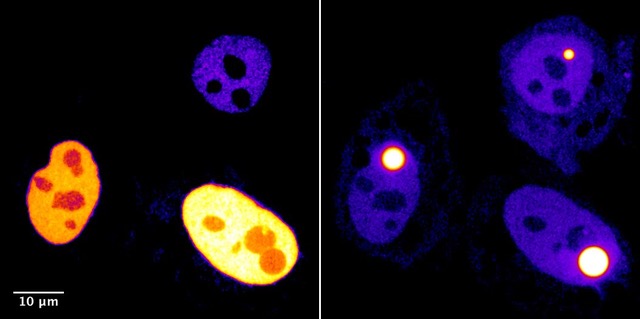
HeLa cells showing a variable expression of fluorescent proteins. The different expression levels are shown by different color intensity (yellow, orange and purple). The phase-separating protein (right image) that forms liquid droplets (bright disks) shows similar intensity between individual cells. © Adam Klosin, MPI-CBG
Biochemical processes inside cells often show a substantial degree of randomness. Gene expression is a prime example in this context: even though two cells might be genetically identical, the concentrations of the proteins that are made from the genes may vary substantially due to random events during transcribing and translating the genetic code. How cells manage to function reliably in the presence of such unpredictable “noise” is an important question that is still poorly understood.
An interdisciplinary team of researchers around Christoph Zechner, group leader at the CSBD and the Max Planck Institute of Molecular Cell Biology and Genetics (MPI-CBG), and Tony Hyman, director at the MPI-CBG, has now described a potentially very effective mechanism for noise reduction in cells. Together with colleagues from the labs of Alf Honigmann (MPI-CBG) and Frank Jülicher (MPI-PKS), the scientists showed theoretically and experimentally that liquid droplets can suppress random variations in protein concentration. If a cell has too many molecules at a time, excess molecules can segregate into a condensate where they are stored. If the concentration drops again, these molecules are released from the droplet to counter-balance the loss of molecules. Such “storage compartments” form via phase separation, a process where molecules de-mix into liquid phases, as seen for instance when oil separates from vinegar.
Florian Oltsch, one of the two lead authors from the Zechner lab says, “We first developed a theoretical model, which allowed us to study how fluctuations in protein concentration are affected by liquid droplets. This theory predicted that for a broad range of conditions, noise reduction should take place.” His colleague and co-first author, Adam Klosin from the Hyman lab, continues, “It was very exciting when we then tested our theoretical predictions in living cells. Indeed, we found that variations in protein concentration were reduced substantially as soon as droplets formed. Phase separation seems to reduce noise in cells.”
Christoph Zechner adds, “Our project is a prime example for the collaborative and interdisciplinary spirit at the Johannstadt-Campus. Experimental biologists and theorists combine their expertise and work closely together. Our work draws an interesting connection between phase separation and biological robustness and will thus be relevant for scientists in both fields.”
A. Klosin, F. Oltsch, T. Harmon, A. Honigmann, F. Jülicher, A. A. Hyman, C. Zechner:
“Phase separation provides a mechanism to reduce noise in cells”,
Science, 24 January 2020, Vol. 367, Issue 6476, pp. 464-468 DOI: 10.1126/science.aav6691